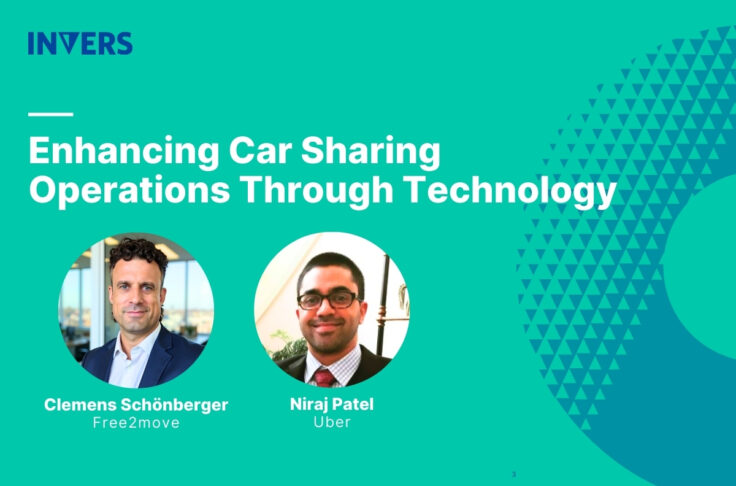Getting More from Ride-Pooling
Summary
Ride-pooling can integrate the concept of automated rentals, making it easier for drivers to share vehicles in the fleet. Another benefit is being able to gain telematics data for vehicle insights and maintenance planning.

One way to categorize the different types of shared mobility is by who is behind the wheel. There is carsharing and scooter sharing where the customer is the driver, and then there are the likes of ride-hailing or microtransit where a customer is the passenger. While our Shared Mobility OS is mainly used in carsharing or scooter sharing services, we have recently explored the integration of our technology in ride-pooling services.
Ride-pooling may not seem like a familiar term, but these services are growing in the industry. Ride-pooling, also known as shared ride-hailing, uses algorithms to determine which route to follow based on demand. Once the route is determined, customers are requested to walk to a more central location for pick-up. In other words, ride-pooling enables people to share a vehicle ride with others who are going in the same direction, offsetting the transportation cost with multiple passengers in the vehicle. Think of it as carpooling organized with technology.
At this point, ride-pooling may sound like MOIA or Chariot, microtransit services that are also growing in popularity. Microtransit is a subset of ride-pooling, but ride-pooling itself is broader and not limited to mini-busses or shuttle busses. uberPOOL, Lyft Line, and CleverShuttle are examples of ride-pooling services currently in the marketplace.
The Technology
The basic foundation needed to enable ride-pooling include GPS technology and algorithms (UC Davis Institute of Transportation Studies). In order to build-up the value proposition of ride-pooling services, operators can look towards technology like the Shared Mobility OS.
Integrating the Shared Mobility OS into a ride-pooling operation will allow you to leverage vehicle data and develop further insights into user trips, vehicle efficiency, and more. As more players enter this market, it will be even more important to position yourself with value-added features to stand out against the competition.
High Frequency GPS
One way to get people out of personal vehicles is by having shared mobility be more convenient and save the person time. Ride-pooling can better position itself as a viable first-and-last mile option to public transportation if it can provide timely, reliable service to its users.
As mentioned earlier, GPS is a key piece of technology that makes ride-pooling run seamlessly and effectively. Without accurate GPS positioning, users may be waiting longer than normal for their ride to arrive.
In any ride-pooling service, GPS information is already available via the driver’s phone’s GPS signal. From our technical experience, this system is not flawless, because it relies on a multi-purpose device locating the GPS signal, which would then have to be transmitted to the user-facing app.
Instead, in-car hardware can be installed into vehicles to provide high frequency GPS data, and have multiple methods of collecting this data. With GPS data coming from the vehicle, you do not have to worry about any issues a driver may have with his phone, or the accuracy of different phone model’s GPS. In addition, the greater degree of accuracy will help you provide a reliable ride-pooling experience for your customers.
Efficient Fleet Access
With the exception of microtransit fleets where shuttles or mini-busses are used, ride-pooling fleets are typically made up of drivers’ privately owned vehicles. However, this does not mean that the future of ride-pooling is restricted to this set-up.
As shared mobility services are becoming more of a commodity to users, operators may want to consider offering a fleet of well-maintained, electric or fuel-efficient vehicles for the drivers to use. By offering a dedicated ride-pooling fleet, operators can ensure users have a pleasant in-car experience while further reducing the carbon footprint with low-emission vehicles.
Providing vehicles for drivers to use only makes sense if it can be done easily and efficiently. Vehicle utilization would be a concern, as a car sitting idle and unused would be less than desirable. To address this, ride-pooling operators need to implement an automated rental system where vehicles can be rented without any in-person key exchange and is not restricted to certain business hours.
Imagine being able to schedule your drivers around the clock, without having administrative staff arranging the key turnover logistics. This way, you can also reduce the need to increase fleet size when growing your operations. With the opportunity to reduce your capital costs, this makes your business easier to scale and meet consumer’s growing needs.
Vehicle Insights
In any shared mobility scheme, vehicles play a critical role – it is what gets a user from A to B, and it also collects data that can provide valuable insight for future operations. However, managing this data and making sense of it is a challenge that operators may not have the time to figure out.
From a fleet management perspective, an operator would benefit from knowing if a vehicle battery is close to draining or the check engine alert is engaged. An operator would only know this if he physically goes to the vehicle or it is reported by the driver. However, both these options may be subject to neglect, making vehicle maintenance a pain to keep track of.
Any ride-pooling operator, especially in microtransit services, would appreciate this data in order to better plan vehicle availability for next week’s scheduling of drivers. The last thing you would want is to have a vehicle with low fuel start a route but have to be returned in the middle of the day, impacting the availability of your service.
In addition, UC Davis Institute of Transportation Studies concluded in their latest ride-hailing study that more data collection and analysis effort is needed on both the operator and city side to get a better understanding of shared ride-hailing’s impact on urban environments. If operators are able to collect better vehicle and therefore trip utilization data, further studies can be done to learn more about this type of service.
Growing into the Future of ride-pooling
As we have seen with the advancements in shared mobility services, operators need to continuously look for ways to improve their service offering or broaden their business scope. Collecting high frequency GPS, enabling automated rentals, and getting vehicle insights may seem like an operator’s wish list, but it can be achieved with the right technology. Specifically, the Shared Mobility OS offers the CloudBoxx, an in-car piece of hardware that communicates and collects the needed data to make the wish list items a reality.
The CloudBoxx is a complex piece of hardware that reliably serves multiple purposes. Because it connects to the vehicle via CAN bus, a ride-pooling operator can collect data right from the source and gain insight that would otherwise not be communicated to the backend system.
Similarly, the GPS module in the CloudBoxx uses both satellite and automotive dead reckoning to determine the vehicle location. Having these two systems in place provides the reassurance of having a secondary source of data in case one does not work in unusual cases.
Automated rentals become a reality with the CloudBoxx because it can control vehicle lock and ignition. This means that you can securely keep the vehicle key inside of the car, and access can only be gained with proper authorization via the operator’s driver app or an RFID card. Even if someone broke into the vehicle, the immobilizer will be engaged and the thief will not be able to steal the vehicle.
These features may provide the competitive advantage you need to gain more market share and be the convenient service people will rely on. If you would like to see a demo of how the CloudBoxx in our Shared Mobility OS offering can strengthen your ride-pooling service, please contact us.


